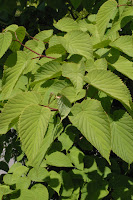 |
| Liriodendron tulipifera |
The Tulip Tree has flowered. It seems not that long ago that it was planted, and some nine or ten years is very early for it to flower, but for six years it has been enclosed within the chicken run and has had a regular supply of high powered guano ever since. As the seasons came and went it changed from just looking handsome to looking magnificent and I have become immensely proud of it as I tell my neighbour on who's boarder it lives. Alas he seems less concerned with its beauty and more with the fact that it could reach a height of 36 metres. Ah, but I say, by then we will not be around and it will be someone else's problem.
 |
| Ginko biloba |
 |
| Wisteria alba |
 |
| Cercis siliquastrum |
Newer plantings at the front are the Japanese strawberry tree (Cornus kousa chinensis), after seeing a truly beautiful specimen at Wisley gardens, and a Handkerchief or Dove tree (Davidia involucrata) in the gardens at Nymans. Last of the exotics is the Golden rain tree (Koelreutria paniculata var. fastigia) because being columnar it fitted in. At the side is a large (and getting larger) Copper Beech of dubious origin being self sown so perhaps should be labelled f. purpurea. Now that's one that will be a headache, and soon.
 |
| Cornus kousa chinensis |
The house being called Cherry Trees has of course to have Cherry trees in it, so dotted around are the usual Champagne, Flagpole, Pendula and Serrula Cherries. We do have one great leveller here and that is honey fungus. Never a year goes by without losing a tree or shrub. One minute they look fine and dandy and next they are as dead as the proverbial dodo. Its loss is of course really an opportunity - to plant something new!
All the houses here have been built on what was once the immense estates of the Hope family (they of the diamond fame) called Deepdene, and the road that runs along side us was once the coach drive to the Mansion. As with all great estate owners at the time it was a matter of great pride to have the latest introductions sent back by plant hunters, and when you walk around you can still see them. One house has two Sequoia, both the giganteum and the sempervirens, luckily it also has grounds large enough to take them. There are also several Monkey puzzles (Araucaria araucana) of good size and many more that have self seeded. Maybe I should plant a Wollemi pine since its the same family (maybe not). Close by is a Douglas Fir which is now the largest in Surrey even if it has lost its top, and a grove of gnarled Sweet Chestnut of immense girth. I can only admire the people who planted these trees knowing that they would never see them grow to maturity. If you want to see magnificent trees still in original settings of the great estates there are several worth a visit in the South East. Wakehurst Place, Sheffield Park, Nymans and Borde Hill, all in Sussex, and of course Kew Gardens in Surrey.
 |
| Araucaria arucana |
Books to recommend are,
Collins Tree Guide (complete field guide) by Owen Johnson & David More.
Remarkable Trees of the World & Meetings with Remarkable Trees, both by Thomas Pakenham.
The Heritage Trees Britain & N. Ireland, by Jon Stokes & Donald Rodger.
Trees, by Hugh Jonson.
Trees of India, by Dr Subhadra Menon.
The Book of Leaves, by Allen J Coombes. and
Foliage, a collection of the most beautiful photographs I've ever seen by Harold Feinstein that I picked up in the bargain bin on a visit to Mount Vernon.

No comments:
Post a Comment